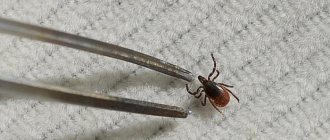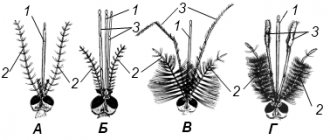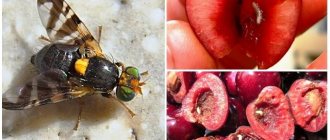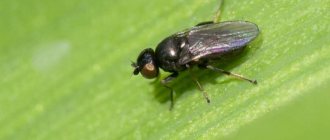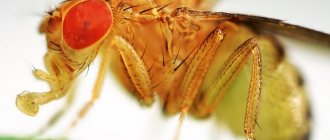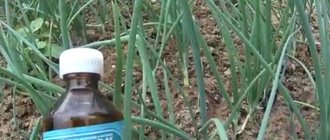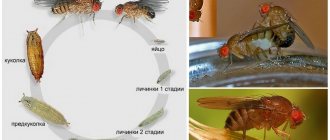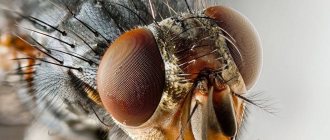Description of appearance
Flies of medium size up to 7 mm, yellow in color.
The wingspan reaches 5 mm. The head is colored more intensely. The entire body is covered with small dense hairs. A pair of transparent wings with four transverse yellow stripes. There are small antennae on the head and well-defined eyes. A photo of the melon fly can be seen below. The larva is born extremely small - about 1 mm. As it matures it grows to 11 mm. The body is cylindrical, dirty yellow, widening towards the posterior end, smooth. At the last stage of development, pupation occurs.
On a note!
The pupa is dark yellow, closer to brown. Size – 8 mm. The melon fly spends the winter in this state. When the larvae develop in early summer, the imago appears after a few days. The ability to fertilize develops within 24 hours.
Melon diseases
Insects that gnaw through the leaves and fruits of melons spread pathogenic microorganisms - viruses and bacteria that cause various diseases in melons. Infection also occurs through untreated seeds, remains of stems and roots.
In unfavorable weather and excessive humidity, fungi multiply, which also often leads not only to a decrease in yield, but also to the death of the plant.
Fusarium wilt (fusarium wilt)
The disease, which begins with rotting of the roots, affects the entire vascular system of late and mid-ripening melons. A fungal infection from the ground rises to the stems. When affected by fusarium, the basic functions of the plant are disrupted; it dies because the mycelium clogs the blood vessels and releases toxins.
Contribute to the development of the disease:
- improper care;
- dense planting;
- water stagnation;
- excess humidity;
- heatwave.
Melon leaves infected with fusarium wilt lose their green color and become covered with spots of an unpleasant grayish color. The diseased plant dies within a week.
To prevent the occurrence of fusarium, the seeds must be treated with formaldehyde before planting; before melon buds form, they should be sprayed with potassium chloride. Agronomists advise choosing a place for crops not in the lowlands, but in the hills.
See also
Description and technology of growing Vietnamese melon, varieties
Read
Gray mold
Cold weather combined with prolonged rains increases fungal activity. They affect young fruits, melons become moldy, turn black, and soften. The disease develops quickly at low temperatures and subsides with heat.
Powdery mildew
The stems and leaves of the melon crop are often covered with small spots that quickly spread throughout the above-ground part of the melon. The brown tint of the plant indicates that it has been affected by powdery mildew. With further development of the disease, the leaf plastics curl and the stems dry out.
Having noticed the first signs, melon plantings are sprayed with a solution of sulfur powder. The treatment is repeated several times, the last time - 3 weeks before the fruit ripens.
Downy mildew (peronospora)
Yellow spots sometimes suddenly appear on melon leaves, and the lower part of the leaf becomes covered with a purple coating. With sharp fluctuations in temperature and high humidity, downy mildew develops quickly. The fungi that cause the disease penetrate the spores of the leaves, and the plant dies.
To prevent the appearance of powdery mildew, the seeds of the crop are heated in hot water or soaked in a solution of potassium permanganate. Melon beds in which specimens infected with peronosporosis are found are sprayed with urea or Bordeaux mixture.
Cucumber mosaic
Viruses carried by insects cause serious diseases in melon crops. If the leaves on young plants curl and become deformed, and tubercles appear between the veins, this indicates an infection with cucumber mosaic. As the disease progresses, the stems become covered with cracks, flowers fall off, and the surface of the melon is disfigured.
Root rot
Weak plants are very sensitive to both viruses and bacteria and often die in unfavorable weather. Melons are often affected by root rot. With this disease, the stems become thinner, their lower part turns brown, the leaves turn yellow and wither, and the pulp begins to deteriorate. Dark spots inside the melon quickly increase in size. The disease is transmitted by seeds, so before planting they are placed in an aqueous solution of formaldehyde for 5 minutes.
White spot (septoria)
After cold and prolonged rains, light, round spots appear on the stems and leaves of the melon. The fungal infection is transmitted with seeds, gets in with plant debris and causes septoria. Mycelium spores spread quickly, the leaves of the crop darken. To prevent the disease, melon beds are sprayed with Bordeaux mixture.
Corner spot (bacteriosis)
During heat and high humidity, greasy brown stains appear on the melon stems, and cloudy drops form on the back of the leaves. Corner spot also affects the fruits, they become like glass, the skin of melons becomes sticky.
Ascochyta blight
In cold weather, which is combined with high humidity, the melon crop is affected by one of the most severe fungal diseases. With ascochyta blight, barely noticeable spots appear on the stems. They quickly increase in size, the root collar dries out, and ripening melons turn black and disappear.
Anthracnose (scarden)
If crop rotation is not observed, or frequent and abundant watering occurs, round pink spots appear on the leaves of the crop, in place of which holes form. With a melon disease such as anthracnose, the vines of the plant become thinner, break when touched, and over time the leaves curl into a tube and dry out. When infested with copperhead, the melon flesh will have brown spots that spread quickly and the fruit will rot.
Lifestyle
The puparia overwinters in the soil where infected crops grew. In spring, when the temperature rises to +15 degrees Celsius, an adult melon fly appears. For about a week, adults feed on flower nectar and fruit juices. Summer time coincides with the flowering period of melons. The first mating season lasts up to one month. In total, 3 generations of melon flies are replaced during the season.
On a note!
After mating, the females begin laying eggs. Do this one egg for each fruit. Each female lays up to 120 eggs. The process lasts 30 days. Under favorable conditions, after 3-4 days, larvae appear, penetrate into the pulp of the fruit, and begin to actively feed on juices.
The maggot develops for about 18 days, then leaves the fruit, falls to the ground, and pupates. After a few days, an adult fly appears, ready to reproduce. The pupal phase lasts 10-20 days in summer, 45 days in autumn. During the puparia phase it overwinters.
Rural Herald
Melon is an exotic guest on our table, very popular among all lovers of melons. The homeland of this false berry is in Central Asia. This sweet and juicy berry is harmed by both specific and omnivorous insects.
Melon fly (Myiopardalis pardalina (Bigot)) is a dangerous quarantine pest that parasitizes the fruits of the pumpkin family, the main enemy of melon fields, included in the Unified List of Quarantine Objects of the Eurasian Economic Union, approved by the Decision of the Council of the Eurasian Economic Commission dated November 30, 2021 No. 158, limitedly distributed on the territory of member countries of the Eurasian Economic Union.
The insect is common in countries where melons are actively grown. In Russia it lives in the Rostov, Volgograd, Astrakhan regions, and the North Caucasus. They are actively fighting the parasite in India, Africa, Syria, Turkey, Iraq, and Iran. To prevent contamination of other areas, products undergo thorough phytosanitary control and pre-treatment.
To protect your crop, you should know what the melon fly looks like and how dangerous it is: This is a small insect of the variegated fly family (the body reaches up to 7 mm in length). The melon fly pierces the soft tissue of the ovaries or young fruits, laying eggs in them (one female lays up to 120 eggs). After 3-4 days, under favorable conditions, the pest penetrates into the pulp of the fruit, where, feeding, it makes numerous winding passages. The lifespan of the larvae is about 10 days. Before pupation, it leaves the fruit and is drilled into the ground to a depth of 15 cm. After 2-3 weeks, a new generation of melon flies appears. During the entire warm season, about 3 generations are replaced. Melon flies parasitize from early June to October.
Damage to fruits in the area of distribution of the species in some years can reach up to 50-70% and even 100%. The first signs of melon fly damage are the appearance of small tuberculate spots or simply tubercles in places where the fruit has been bitten. Places where the flesh is punctured can serve as a breeding ground for the development of viral and fungal diseases. Later, after the development of the larvae, internal rotting of the fruit begins. Damaged fruits, as a rule, rot and become unsuitable for further use, slow down their formation, and reduce the quality and quantity of the harvest. The adult also harms plants; droplets of fruit juice appear at puncture sites, which the fly itself feeds on (insects are very voracious).
Agrotechnical methods of control include deep fall plowing, crop rotation, the use of early ripening varieties and hybrids, pre-soaking and treating seeds before sowing. Chemical methods include preventive treatment of crops in the phase of leaf emergence and weaving with insecticides. During the flowering phase and before harvesting the fruits, chemical treatments are not carried out.
The melon fly is not found in our area, but there is a risk of it entering us from the southern regions, from where melons and watermelons are now imported in large quantities.
It is very important to be alert not only for farmers, but also for ordinary consumers. You won’t eat such a melon, but you shouldn’t just throw it in the trash. It is advisable to bury it in the ground. Or you can bring the affected fetus to the laboratory of the Federal State Budgetary Institution TsNPVRL (Barnaul, M. Gorky St. 4B).
For other questions regarding plant quarantine, please contact the Department of Quarantine Phytosanitary Surveillance at tel. in Barnaul 66-83-27
Life cycle
Spring summer coincides with the formation of fruits in the spring. By that time, the soil temperature warms up to +20 degrees Celsius. The summer period extends up to 30 days. During the entire warm season, about 3 generations are replaced. Melon flies parasitize from early June to October.
The lifespan of adult females is 2 months; males die after the end of summer. Females lay eggs almost every day in developing fruits, one in each. Avoids large fruits where the skin becomes dense. Buries the eggs 2 mm under the skin.
On a note!
Throughout her life, the female lays 100 eggs.
The female feeds on the juices of the same crops. The droplets protrude to the surface and are calmly drawn in by the long proboscis. Males do not damage fruits on their own, but use the holes made by females.
The development of the melon fly larva in the egg lasts from 2 days to a week, depending on climatic conditions. After emerging from the shell, the worm penetrates deep into the fruit. It feeds on seeds, juice, pulp. She sheds 3 times. The entire development cycle in summer lasts 8-13 days, in autumn it lasts up to 18 days. After the third molt, they leave the fruit and burrow into the ground. On clay soils it penetrates 13 cm deep.
The development of the pupa lasts about 20 days. Autumn puparia overwinter. At the beginning of summer, when the soil warms up to +20 degrees Celsius, adults appear. In a few days the years begin.
Diseases and pests
Low temperatures, high humidity, lack of heat and sun - all these factors contribute to the development of putrefactive processes on leaves and fruits. Most often, melons are susceptible to diseases caused by a fungal infection that affects plants in the absence of proper care.
Powdery mildew. At the initial stage it appears as whitish spots on the greenery of plants (leaves, stems). If measures are not taken in time, the spots become brown and spread over the entire surface, and the leaves themselves dry out. This process leads to a stop in fruit growth and a decrease in their quality. In many cases, the disease affects not only the greens, but also the fruits themselves.
Fusarium. This is a fungal disease that causes the leaves to wilt. As a rule, it occurs during the formation of the first leaves, active growth and ripening of fruits. In the absence of immediate measures, withered leaves, and then the stems, lose their color and become covered with spots. You can no longer count on a generous harvest, since the process develops so rapidly that literally after 7–10 days the infected plant dies. If the fungus has infected the melon at the stage of fruit ripening, then the melons will not be sweet and aromatic enough. It has been noticed that the disease more often affects melon varieties of medium and late ripening.
Copperhead (anthracnose). Signs are brown spots on the leaves, gradually increasing in size. Over time, holes form in the affected areas, the leaves dry out and curl at the edges, the stems become brittle, and the fruits become deformed, begin to taste bitter and gradually rot.
Root rot. Young, weakened plants are more susceptible to the disease. At the initial stage, it manifests itself as drilling and thinning of the stem, gradually leading to the death of cotyledons, leaves and roots.
In addition to various types of diseases, planting melons is often also attacked by insect pests, which we will talk about later.
Melon fly. In some regions, this pest is the main enemy of melons, as it affects up to 50% of the entire crop. It is quite difficult to get rid of flies, since they easily tolerate cold and safely overwinter in the ground as larvae. These insects begin their flight around the beginning of June and can even penetrate the ovaries. Basically, the pest attacks already ripe fruits. In this case, the insect pierces the soft tissues of the fruit and lays several larvae inside the melon.
The first signs of damage to fruits by the melon fly are small tubercles on the peel where the pest has penetrated. Then, when the insect eggs turn into larvae, you can see holes (soft passages) on the surface of the melon that these same larvae have worn out. Fruits after being damaged by a pest begin to rot quickly, and the risk of infection with fungal diseases also increases. Of course, eating a melon infested with insects is not recommended, even if the flesh of the fruit is not yet seriously damaged and the larvae are easily removed.
Melon aphid. It consists of multiple clusters of small insects below the leaves. Situated in groups and laying larvae there, they suck the juice from the leaves, which leads to their yellowing, curling and wilting. In this case, the entire plant suffers, and the flowers and ovaries fall off.
Wireworms. These are the larvae of beetles, which are popularly called click beetles. Their body really looks like a piece of wire; it is very strong and springy. The larvae live in the soil, feeding on the seeds of melons, so the main damage is caused to melon rhizomes. They gnaw through the roots and underground part of the stem, which leads to developmental delays and then to the death of the young plant.
Spider mite. These pests settle on the lower part of the leaf. Thin webs entwining the leaves indicate a mite infestation. During the day, adult beetles lead a hidden life, hiding in webs and laying larvae there. Colonies feed on plant sap, so small spots can be found on the leaves - traces of pest bites. Infected leaves turn yellow, become deformed and fall off, after which the insects move to the stems, flowers and ovaries. By devouring them, they gradually destroy the plants.
Gnawing owls. These are caterpillars that live both in the soil and on its surface. During the daytime, they prefer to hide from the sun in the ground, where they gnaw through the roots of plants, and at night, they climb to the surface and damage the stems there. Massive damage leads to the death of melons, especially if the root is damaged.
Damage caused by a fly
The crop dies from the activity of the larvae. They penetrate the fetus and devour it from the inside. As a result, the formation of the fetus slows down, as well as its quality.
Adults cause harm only by piercing the skin of melons. This is where the rotting process begins.
Gardeners are advised to pay attention to the following points:
- holes where larvae emerge;
- dark colored tubercles on the surface of the fruit;
- the pulp contains traces of the vital activity of larvae.
Important: sometimes it is visually impossible to determine damage to the fetus.
Why is an insect dangerous?
The main danger of the melon fly is its high fertility. This insect can destroy from 70 to 100% of the melon crop. In addition to traditional melons, watermelons and pumpkins, this pest can threaten about a hundred other plants.
How to determine the appearance of a pest in the beds
The first signs of fruit infection by parasites are the appearance of many small spots or tubercles on them, formed in places where the females bite through the skin. The spots and bumps have a characteristic brown tint.
When the larvae enter the active phase of life, more noticeable traces of damage appear - the fruits begin to rot, and this becomes noticeable quite quickly, 4-5 days after the larvae hatch from the eggs.
Is it possible to eat melons infected with the melon fly?
Despite the fact that the melon fly does not pose a danger to humans, eating fruits affected by it is still not worth it. A small amount of waste products of the larvae, as well as the pulp damaged by them, cause mild diarrhea.
In more severe cases, slight dehydration is observed.
Methods of pest control
The melon fly is not a disease spreader. It only spoils the harvest of melons and melons. Therefore, you need to use the following methods to protect melons, pumpkins and watermelons, namely:
- chemical;
- folk.
The choice of method depends on the number of crops planted and the preference of the gardener.
Effective drugs
To combat the melon fly, biological and chemical preparations are used. They allow you to get rid of flies in the shortest possible time.
Biological products do not pose a danger to the environment; fruits can be eaten after thorough rinsing under running water. The result is observed within 7-14 days after spraying the crops. Effective products Fitoverm, Iskra Bio, Mikosan, Actofit, Biospora.
Chemicals work almost immediately. Maximum effectiveness is observed in the first 4 hours after treatment; toxic properties remain for about a month. Absorbed by crop tissues, kill melon fly and larvae during feeding. It is prohibited to use the poison during the flowering period, later than 20 days before harvest. Immediately before use, the concentrate is diluted with cold water in the ratio specified in the instructions. Effective remedies - Fufanon, Kemifos, Novaktion, Karate Zion, Agita. The crop should be treated in May, a few weeks before flowering.
Methods for controlling melon fly
To destroy pests, several control methods are combined, and preventive measures are required.
Agrotechnical methods include:
- deep plowing of the soil after harvesting, before sowing new beds;
- compliance with crop rotation;
- the use of hybrids that are resistant to damage by larvae, diseases, and fungal infections;
- destruction of the remains of the infected plant by burning.
Before planting seeds in the soil, pre-soaking in chemicals is recommended. Treatment of melon against melon fly with insecticidal preparations is allowed at the stage of appearance of the first leaves. It is forbidden to spray formed fruits with a poisonous agent. Some chemicals are introduced into the soil along with fertilizers. Do not use toxic substances during the flowering period of crops, 20 days before harvest.
Morphologically related species
In terms of the morphology (external) appearance of the adult, Gonioglossum wiedemanni is close to the described pest. The main differences: the mesonotum is yellow, there are several black spots on the sides and back; wings with four brown bands, the third and fourth are fused along the anterior margin; body length 4–5 mm; The larva feeds in the fruits of the footweed. [1]
In addition, larvae of Carpomyia vesuviana are often found in rose hips; their adult morphology is similar to the Melon fly (Myiopardalis pardalina). [1]
Features of insect development
The body of the melon fly, 5–6 mm long, is pale yellow, and its abdomen is orange. The shape of the eggs is oblong. Having pierced the tissue of a young fruit, the fly lays eggs. The appearance of larvae occurs within 2 days, although at unfavorable air temperatures the process may take a week. The larvae are white in color and approximately 1 cm long.
They drill into the pulp, making moves and provoking the process of decay. Full development occurs in the larvae within 1 - 2 weeks. After this, pupation occurs in the soil, where they climb to a depth of 10–15 cm. After 15 - 20 days, adult individuals appear. Usually two generations develop, but if the weather is warm for a long time in the fall, a third may appear.
Damage caused
The main diet of flies of this species is the juice of melon, cucumber and watermelon. The feeding process occurs by consuming the liquid flowing out after the fruit is pierced by the ovipositor. Females lay eggs under the skin of the fruit, and in the part that does not come into contact with the soil. In places where eggs are laid, tubercles or small droplets of juice can be seen on melon fruits.
After the larvae leave for pupation, round holes with a diameter of approximately 3 mm can be found on the surface of the melons. Fruits damaged by the pest are riddled with rusty-brown burrows. They are very visible between the seeds, as well as on the inside of the pulp.
African melon fly
The official name is Bactrocera cucurbitae coquillett. Lives in tropical countries, parasitizes all year round. Distributed in Africa, Asia, USA, Oceania. Affects 125 species of plants from the pumpkin family:
- melon (Cucumis melo);
- giant pumpkin (Cucurbita maxima);
- watermelon (Citrullus lanatus);
- cucumber (Cucumis sativus);
- pumpkin (Cucurbita pepo);
- citrus fruits (Citrus);
- papaya (Carica papaya);
- mango (Mangifera indica).
Symptoms of damage are punctures in the peel, signs of rotting. Spread with infected fruits and soil. The fight is carried out using combined methods.


